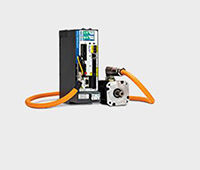Laird has developed self-contained liquid cooling systems (LCS) that deliver optimal temperature stabilization for more precise temperature control in particle accelerators like linear accelerators (LINACs) and cyclotron systems. LINACs and cyclotrons increase the kinetic energy of particles for use in a variety of applications, ranging from scientific studies on particle physics to radiation therapy for cancer patients. Temperature control within the linear accelerator and cyclotron systems is critical for operational integrity, performance accuracy and system reliability.
 One example of a LINAC system is Intensity-Modulated Radiation Therapy (IMRT) equipment used for treating cancer. IMRT equipment requires thermal consistency to maintain beam energy and stability. The tungsten target, the waveguide, the acceleration chamber, and the magnets all require thermal management to dissipate heat buildup and maintain temperature stability for optimal operation. Even the cabinet electronics, amplifiers and power supplies, require cooling due to the heat generated during operation. For example, certain components in an IMRT system, such as the process board, require thermal control within about 0.5 degree C.
One example of a LINAC system is Intensity-Modulated Radiation Therapy (IMRT) equipment used for treating cancer. IMRT equipment requires thermal consistency to maintain beam energy and stability. The tungsten target, the waveguide, the acceleration chamber, and the magnets all require thermal management to dissipate heat buildup and maintain temperature stability for optimal operation. Even the cabinet electronics, amplifiers and power supplies, require cooling due to the heat generated during operation. For example, certain components in an IMRT system, such as the process board, require thermal control within about 0.5 degree C.
Cyclotron systems, like Positron Emission Tomography (PET) scanners, require cooling of both the cyclotron equipment that generates the radioactive substance and the detector banks in the imaging system. The amplifiers, power supplies, and vacuum chamber also need cooling. To avoid noise in the image due to leakage current, the detectors need to be kept at a constant temperature relative to one another.
Liquid cooling systems recirculate coolant to a predefined set-point temperature, while dissipating the large amount of heat generated in the densely packed electronic environment of IMRT and PET systems. An LCS offers higher efficiency than air-based heat exchangers and provides more rapid cooling, quieter operation, higher reliability, and increased system uptime.
Laird offers three types of liquid cooling systems to meet most any application demands: liquid-to-air configuration; liquid-to-liquid configuration; and compressor-based chiller system. Depending on system requirements, additional features for precise temperature control and variable coolant flow rate, coolants with corrosion inhibitors, and coolant filtration are available. In IMRT and PET systems, temperature control of multiple liquid circuits is often required, as is high operational temperature. Control of multiple pressure, flow, and temperature settings can easily be accommodated in a single system design.
Given the complexity of some IMRT and PET systems, usage of a custom designed LCS with plug-and-play components may be a good solution. For example, quick connect fittings allow easy service and maintenance, such as a bottom drain for removing the coolant by gravity, or a pump that is easy to swap out to simplify ease-of-service. Custom housing configurations for unique environments may also be required. Laird has the knowledge to custom design liquid cooling systems for linear accelerator and cyclotron applications, as well as the experience to support and service them.
“The increasing intricacy of thermal management means that linear accelerator and cyclotron systems often require custom liquid cooling systems. Laird’s experience in the design, manufacturing, and servicing of liquid cooling systems, as well as our expertise in pumps, compressor technology, heat exchangers, and electro-mechanical controls allows IMRT and PET manufacturers to focus on their end product design, while leaving the thermal management issues to the experts,” said Anders Kottenauer, Senior Vice President of Laird’s Engineered Thermal Systems Business.
Laird
Filed Under: MOTION CONTROL





Tell Us What You Think!